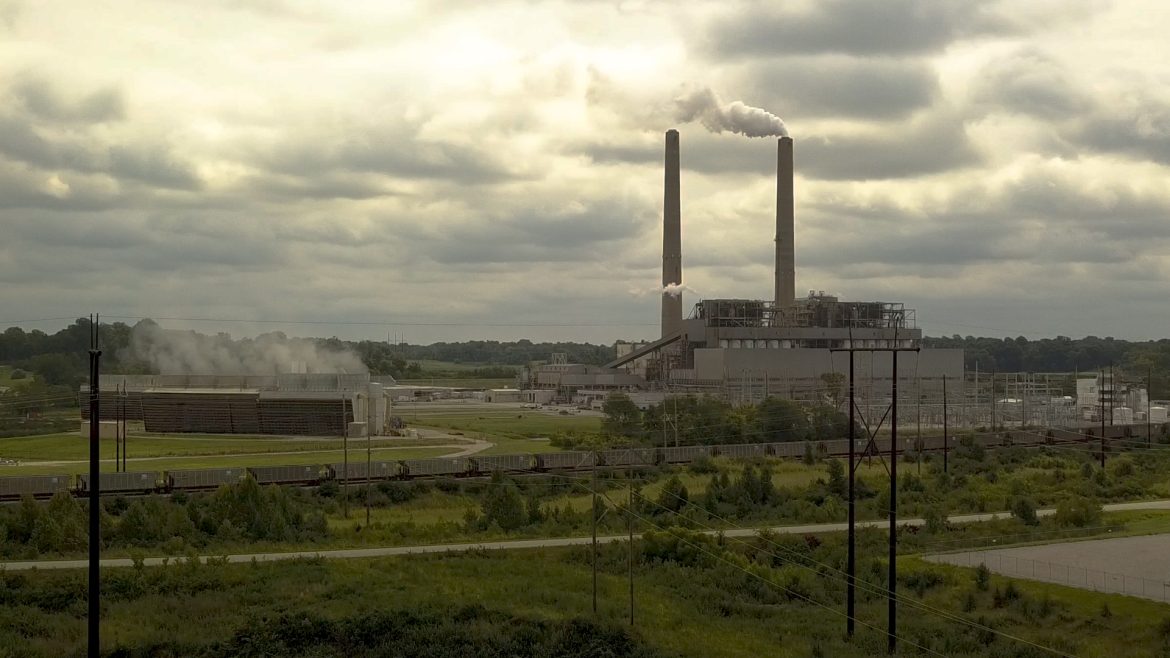
A power plant in Petersburg, Indiana, burns coal to produce electricity near a residential area. Image: Beyond Coal Campaign
By Vivian Barrett
Although it is the country’s eighth largest coal producer, Indiana has significantly decreased its use of the fossil fuel to generate electricity over the past decade.
As the state moves from coal, activists are fighting for the use of renewable resources such as wind and solar instead of natural gas. Although less than coal, natural gas still emits greenhouse gases, primarily methane, the U.S. Energy Information Administration reports.
Federal officials report that Indiana contains approximately 1.5% of all economically recoverable coal in the country. The state is also a top consumer of coal, burning 33 million tons in 2021 and securing a place as the nation’s third-largest coal consumer that year.
Despite the state’s leading coal use to generate electricity, consumption has declined almost every year since 2010, according to the Energy Information Administration.
Coal-fired electricity declined from 90% of total generation in 2010 to 58% in 2021, the agency reported in 2022.
In 2016, coal activists expressed hope that a lack of federal policy would boost coal use. The progress in coal retirement is not due to climate-focused legislation but the increased availability of natural gas, said Nikos Zirogiannis, a public and environmental affairs professor at Indiana University.
“When horizontal drilling and hydraulic fracturing really took off as a technology in the U.S. in about 2006, we started seeing a real boom in domestic natural gas production in the U.S., so the price of natural gas declined substantially,” Zirogiannis said. “And that has led to a lot of retirement of coal plants and those coal plants being replaced with natural gas plants.”
A switch to natural gas is not the best solution because that source of energy still produces carbon emissions, said Wendy Bredhold, a Beyond Coal Campaign activist. The goal is for utilities to switch fully to renewable energy sources, she said.
“For the last few years, (the campaign has) also been about preventing a rush to build new gas plants,” Bredhold said. “So, we’re simultaneously now trying to retire coal, stop a rush to new gas and ensure that utilities are replacing their fossil fuels with renewable energy.”
The work to retire coal and prevent natural gas use is happening with limited legislative backing, Zirogiannis said. That makes it difficult to change to renewable resources while preventing the many economic implications the shift would cause; One of the main arguments against retiring coal is the economic repercussions against coal workers and coal mining communities.
The National Mining Association reports that there are 21,915 jobs directly or indirectly attached to the coal mining industry. To swiftly transition energy sources, there needs to be a drastic expansion of renewable energy, occupational training for those whose jobs will be affected and expansion of the transmission network, Zirogiannis said. Expanding the transmission network will offer additional jobs for the state.
There are also technical hurdles. A grid that doesn’t produce carbon emissions requires batteries that can store energy for two or three days.
“And so, we need very big infrastructure investments,” Zirogiannis said.
Bredhold agreed, saying that the biggest issues facing the retirement of coal are the amount of renewable energy available and the ability to transmit it across the state.
“Honestly, the challenge in my opinion is no longer convincing the utilities, except for a few outliers like Duke Energy, to retire their fossil fuels,” Bredhold said. “But the challenges are really around developing enough renewable energy fast enough.”